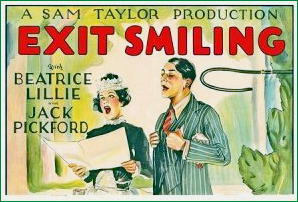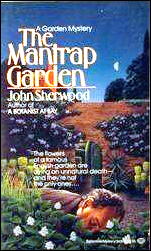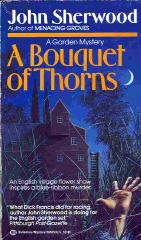July 2010
Monthly Archive
Mon 12 Jul 2010
REVIEWED BY WALTER ALBERT:
EXIT SMILING. MGM, 1926. Beatrice Lillie, Jack Pickford, Doris Lloyd, DeWitt Jennings, Harry Myers, Franklin Pangborn. Story: Marc Connelly; scenario: Sam Taylor & Tim Whelan. Director: Sam Taylor. Shown at Cinecon 27, Hollywood CA, September 1993.
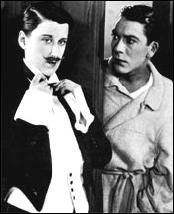
After the discovery of Jessie Matthews [in First a Girl, reviewed here ], Beatrice Lillie was the rediscovery of the convention for me.
Lillie is the maid for a touring theatrical company, and also plays small roles like “Nothing” in “Much Ado About Nothing” (as the intertitles put it), while pining to show the company that she can play leading roles.
The film is filled with inspired bits of tomfoolery that make you wonder why Lillie was not one of the great comic stars of the silent screen. In any event, a marvelous showcase for her talents, and for those of actors like Franklin Pangborn and Doris Lloyd.
There’s a tug at the heartstrings at the end, and I exited smiling and treading on air.
Editorial Comment: This movie is available on DVD from the Warner Archives website.
Sun 11 Jul 2010
REVIEWED BY BARRY GARDNER:
JOHN SHERWOOD – Creeping Jenny. Charles Scribner’s Sons, hardcover, 1993. Celia Grant #9. No US paperback edition. Macmillan, UK, hardcover, 1993.
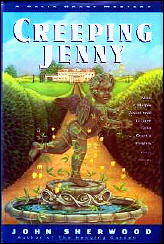
Celia Grant is a horticulturist, and owner of Archerscroft Nurseries, which specializes in the rarer and more rarely seen varieties. She also finds time to become embroiled in various forms of shady doings.
Celia hires for the summer a painfully shy girl whom she doesn’t really take to, the Jenny of the title. She’s even less fond of her after she seduces Celia’s head gardener, and then is apparently kidnapped.
The investigation leads to a radical environmental group who are threatening dire consequences to a local garden show, among other more serious things, and all this at a time when Celia is in the middle of a squabble between a local landowner and an industrialist new to the area.
I like this series. Celia is an enjoyable character, and I think one of the better realized crop of British amateur sleuths. Sherwood writes well, and generally tells a good story, occasionally with a little edge.
Though not really hardboiled, Celia isn’t Miss Marple. Some in the series have more depth than others, but they are usually peopled with interesting characters, and the plots are usually adequate.
I don’t think this is one of the stronger entries, but it was certainly readable, and stopped short of being disappointing.
— Reprinted from Ah, Sweet Mysteries #10, November 1993.
The Celia Grant series —
1. Green Trigger Fingers (1984)
2. A Botanist at Bay (1985)
3. The Mantrap Garden (1986)
4. Flowers of Evil (1987)
5. Menacing Groves (1988)
6. A Bouquet of Thorns (1989)
7. The Sunflower Plot (1990)
8. The Hanging Garden (1992)
9. Creeping Jenny (1993)
10. Bones Gather No Moss (1994)
11. Shady Borders (1996)
John Sherwood had a crime-writing career than spanned six decades. He was not uniformly prolific throughout that time, but he had two periods in which he was very active. Starting out in 1949 with a longish series of adventure and espionage novels, including several with a series character named Charles Blessington, he wrote only four in the 1960s and 70s. He might be best known for a book called Death at the BBC (as it was titled in the US) in 1982, then came the long run of Celia Grant books.
Sun 11 Jul 2010
Posted by Steve under
Reviews1 Comment
IT IS PURELY MY OPINION
Reviews by L. J. Roberts
DERYN LAKE – The Mills of God. Severn House, UK, hardcover, 2010.
Genre: Traditional mystery. Leading characters: Rev. Nicholas Lawrence/DI Dominic Tennant; 1st in series. Setting: England.
First Sentence: It was, thought Nick, peering through the windscreen of his
somewhat battered red Peugeot, a very oddly shaped village.

The Reverend Nick Lawrence arrives at his new perish in the village of Lakehurst. Awaiting him is an assortment of village characters, a 16th century vicarage, complete with ghost, and a serial murderer.
DI Dominic Tennant, and his sergeant, Potter, come to catch a killer before the town’s small population is even further reduced.
Ms. Lake is taking a new direction, moving away from her historical mysteries, which I love, into the contemporary. There are a few stumbles along the way but I’ve also learned that Ms. Lake had a serious issue which necessitated her writing the book much more quickly than normal.
That, to me as a long-time reader of her work, does explain the weaknesses of this book which I am sure would have been corrected otherwise.
The story is set in a very small village, and there are a lot of characters. This could be confusing except that each is very well defined through a nice, brief, comprehensive introduction. Most of the characters come through as stereotypes rather than eccentrics, and I did have an issue with a comment that a married man with a disagreeable wife could decide to go gay.
However, there were some wonderful secondary characters as well and I look forward to seeing them again. I particularly appreciated that there were some relationships that, while confusing to some, worked well for those involved.
The exceptions are our protagonists. Father Nick, the new vicar, is young at 28 and understandably focused, but a bit too much so, on the attractive women of his parish. He is modern and accepting of others. I also appreciated that he doesn’t go blinding off without protection and didn’t try to solve the murders, but rather provided assistance to the police.
The police were well represented by DI Dominic Tennant, who gets tired and misses having a woman in his life, and his sergeant Potter. I very much like the relationship between the two men. These are characters I want to follow and about whom I want to know more.
The sense of place and dialogue needed a bit of work. While some of the descriptions were wonderful, others left me wanted. In the first sentence, we told the village is very oddly shaped, but never in what way or why. The cover art on the hard cover shows deep snow, but snow is never mentioned in the text (I blame the cover artist), and other than a slight reference to cold, the weather and season are never really defined until almost the end.
The dialogue at times flowed very well, but at other times, seemed awkward. What really saved the book was the very well structured plot and Ms. Lake’s ability to portray differing attitudes really well.
You sense of frustration of the police and there is just the right level of menace. There is a small red herring, which I appreciated, and I was never able to anticipate the next move in the plot and certainly not the killer.
I also very much liked the realism that while the “who” of the killer is identified; the “why” is left something of a question both to the characters and the readers.
For its flaws, I enjoyed this book very much. I recommend one forgive the weaknesses — Ms. Lake is a good-enough author to correct them next time out — revel in the strengths, for there are many, and enjoy.
There was definitely more good than bad about the book, as reflected by my immediate reaction of wondering when the next in this series will be available.
Rating: Good Plus.
Editorial Comment: The series of historical mysteries written by Deryn Lake that LJ refers to above currently consists of 13 adventures of 18th century apothecary John Rawlings, who teams up with Sir John Fielding, London’s famous blind Bow Street magistrate, in most if not all of them. Covers for these can be seen on the Fantastic Fiction website.
Sun 11 Jul 2010
Posted by Steve under
Reviews[2] Comments
EMILY BRIGHTWELL – The Inspector and Mrs. Jeffries. Berkley, paperback original; 1st printing, February 1993.
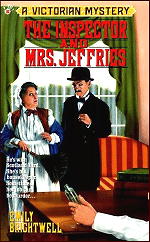
I haven’t seen it, but wasn’t there a movie in which Sherlock Holmes was a bumbling fool and Dr. Watson was secretly the brains of the pair? I don’t know, but that had to be the idea behind this new paperback series set in Victorian England.
The inspector is Inspector Gerald Witherspoon of Scotland Yard. Mrs. Jeffries is his housekeeper, and she solves his cases for him. He is a nice man, but he is so bewildered he does not even suspect that she is doing all his work for him. His entire household staff is brought in on the secret in this case, and together they do 80% of the legwork, 90% of the questioning, and 100% of the thinking.
The dead man is a doctor who has been poisoned. He also had a good many secrets and was universally disliked. (Put two and two together and see what you come up with.)
Personally, I think that this is a good idea that gets awfully tired awfully fast. (Sort of like a TV series that after one or two episodes has no place else to go.) The book is fun to read, without requiring any major brainpower, perfect for late at night when you can’t fall asleep anyway.
The characters are fine, except for the excessively dimbulb wit of the inspector, but just how long can the charade be kept up?
Note: The second of the series, Mrs. Jeffries Dusts for Clues, has just come out, and the third, The Ghost and Mrs. Jeffries, is scheduled for October. Does that answer my question?
— September 1993.
[UPDATE] 07-11-10. I might have gotten tired of the idea after only one book, since I’m sure that this one is the only one I’ve read, but the target audience for the series surely hasn’t. There have been 27 in series, so far, and still counting. Some but not all have come out in hardcover.
Obviously the “gimmick” in this case has had longer legs than I was willing to admit back in 1993, but do note my concluding Note at the time.
Fri 9 Jul 2010
My brother from Canada is visiting this weekend. He arrived around five this afternoon. I think I’ll use the occasion to take a short vacation from the blog. I’ll be back around this same time on Sunday. See you then!
Fri 9 Jul 2010
Steve:
Is there anyway you can enlist your army of mystery fans to help save the TV series Agatha Christie’s Poirot?
This month, series X of Poirot will air on PBS. It may be the last despite there being only 6 Christie stories to be filmed.
Below is an excerpt from www.culturevulture.com with more info and how we can help save the show.
I have also started a Facebook group page called “Save Agatha Christie’s Poirot.”
Thank you!
Brian R. Sheridan
In early 2010, it was speculated the Poirot series might end before the last six stories (out of 71) are filmed. David Suchet said, “I’m pragmatic and accept that things get cancelled. Of course, there are cutbacks in TV drama and if it is not to be, it is not to be. I will have to be a big boy and accept it.” He added, “Of course I would be very sad if it didn’t get recommissioned.”
Suchet also stated in April 2010 that if the series were to return, but on a lower budget scale, he would not want to continue making the last episodes if they would compromise the quality of the program.
So now is the time for fans to let ITV know that we would like ITV to produce the last of the Hercule Poirot stories by emailing ITV at
viewerservices@itv.com.
Or snail mail:
Viewer Services ITV Plc
Gas Street
Birmingham B1 2JT UK
Thu 8 Jul 2010
REVIEWED BY WALTER ALBERT:
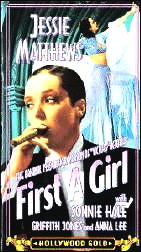
FIRST A GIRL. Gaumont British Picture Corp., 1936. Jessie Matthews, Sonnie Hale, Anna Lee, Griffith Jones. Director: Victor Saville. Shown at Cinecon 27, Hollywood CA, September 1993.
This Jessie Matthews musical remake of the 1933 German film, Viktor und Victoria, was screened in the restored El Capitan theater. I was captivated by Matthews (whom I had never seen before). She’s one of the great favorites at Cinefest, and I can see why: A charming comedienne, a lovely dancer, and at least as good as Julie Andrews in the Blake Edwards version.
The opening musical number featuring a dance by Matthews won me over immediately. I was putty in her hands (or under her feet) from that moment on.
Editorial Comment: The movie was released on VHS (see image), but never, as far as I’ve been able to discover, on DVD.
Thu 8 Jul 2010
Posted by Steve under
Reviews[9] Comments
GEORGE C. CHESBRO – In the House of Secret Enemies. Mysterious Press, hardcover, September 1990; reprint paperback: January 1992.
Quiz time. Can you think of another series character who began his existence in Mike Shayne’s Mystery Magazine and whose adventures eventually ended up in hardcover? (I don’t know the answer, if there is one. I’m only asking.)
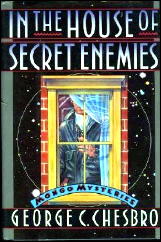
This is the collection of such a man, Dr. Robert Frederickson, a/k/a Mongo the Magnificent. Mongo is a dwarf, a former circus acrobat, a Ph.D. in criminology, and a practicing private detective. There have been at least eight full-length novels chronicling his cases, and wide-open woolly cases they are, indeed.
In his introduction to this gathering of stories from Mike Shayne and Alfred Hitchcock, as well as one from An Eye for Justice (edited by Robert J. Randisi, 1989), Chesbro tells something of Mongo’s creation, and how the character developed.
Part of how Mongo began to take on a life of his own, Chesbro says, was his need to be respected, in compensation for his physical lack of stature. And I think that’s the reason the stories take the direction they do. These are not your ordinary PI bill of fare, none of them.
The first few Chesbro wrote deal with drug smugglers and espionage agents, but when the adventures begin to involve Mongo with agents of sensory deprivation, psychic healing and out-right witchcraft, you know they’ve become more than a step further out.
To tell you the truth, I don’t think there is a world for Mongo other than this. As a character he simply couldn’t live in the world of a Spenser and/or a V.I. Warshawski.
That said, I still have to admit that I liked the “every-day” adventures better — the occult underground really being no match for the much more believable terrors of reality. The final story, “Candala,” a story of the Indian caste system as it still exists today, is my case in point — and it’s the story Chesbro is proudest of also.
Previously on this blog:
Shadow of a Broken Man (A 1001 Midnights review by John Lutz, posted here on the occasion of Chesbro’s death.)
Thu 8 Jul 2010
Posted by Steve under
ReviewsNo Comments
IT IS PURELY MY OPINION
Reviews by L. J. Roberts
JANE HADDAM – Living Witness. St. Martin’s Press, hardcover, April 2009; reprint paperback: February 2010.
Genre: Unlicensed investigator. Leading character: Gregor Demarkian; 24th in series. Setting: Pennsylvania.
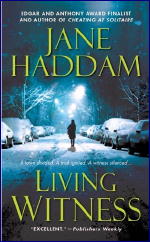
First Sentence: If Ann-Victoria Hadley had been forced to tell the truth — and she never had to be forced; she always told the truth — she would have to admit this was not the first time she had been the most hated person in Snow Hill, Pennsylvania.
An attack on elderly, yet indomitable, Ann-Victoria Hadley summons ex-FBI agent Gregor Demarkian from Philadelphia to the small town of Snow Hill, PA. Ms. Hadley, now in a coma, was part of a law suit against bringing “intelligent design” into the school’s curriculum.
Because the chief of police is a Fundamentalist Christian, he doesn’t feel it would be right to lead the investigation. A second attack results in murder and increasing tension across the various factions in the town.
Any book which deals with differing religious views can be both interesting to read and challenging to review. Ms. Haddam does include characters who fall within several camps; evangelicals, fundamentalists, Christians, secular humanists and atheists.
She also raises issues of snobbery, peer pressure, ignorance and education. I appreciated reading Ms. Haddam’s views on each of these topics and felt she did a very good job integrating them into the plot. For the most part, they were presented without blatant bias against the beliefs but rather against the individual character.
This was the first Haddam book I’ve read but was pleased to find, as far as knowing the primary characters, it didn’t matter. Enough back story was provided for Demarkian and his fiancée that I was very comfortable and didn’t feel anything was missing.
As to the other characters, I should like to have seen a better balance. Perhaps, however, it was only that those who are extreme in their views seem to predominate whatever environment they are in. However, there were some secondary characters I found fascinating but about whom I want to know more.
I fault the author’s desire to focus on the attitudes and philosophies rather than the characters. For all that, the basics of the plot were very good. There was a clever diversion and an unexpected motive.
I was also surprised when I realized that, for the volume of text, the story encompassed only three days. However, there were times one lost the focus of the story for the viewpoints. I felt this was a shame as it diminished what could have been a very good book with stronger editing.
While I enjoyed the book, it didn’t make me want to seek out others in the series.
Rating: Good Plus.
Thu 8 Jul 2010
IT’S ABOUT CRIME
by Marvin Lachman
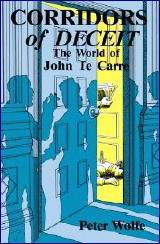
PETER WOLFE РCorridors of Deceit: The World of John Le Carr̩. Popular Press, hardcover/trade paperback, 1987.
— Reprinted from
The MYSTERY FANcier,
Vol. 10, No. 2, Spring 1988.
Peter Wolfe’s Corridors of Deceit is a subtle analysis of the man who brought realism (and, for me, boredom) to the spy story. I clearly am in the minority, as the Best-Seller charts show.
Fans of Le Carré will find this book satisfying because Wolfe is a perceptive writer, as he showed several years ago in his analysis of the works of Hammett, Beams Falling. His may well be the definitive book on the most popular serious spy novelist of our time.
Editorial Comment: This is the fifth in a series of reviews in which Marv covered reference works published in 1987, books about the field of mystery and crime fiction. Preceding this one was Campion’s Career, by B. A. Pike. You can find it here.
« Previous Page — Next Page »

